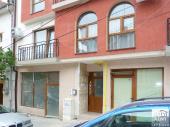|
| Gergiovden: greenery, lamb and merrymaking |
|
|
 "Colorful George went out to go round fields and green woods…” – such lyrics are often found in folk songs that to this day are performed on Gergiovden, the traditional version of St. George’s Feast, May 6. One of the best loved folklore feasts boasts a very rich and colorful set of rituals dedicated to the mythical “handsome, colorful, dear George”. Coinciding with the Orthodox feast of St. George the Victory-Bringer, the traditional day Gergiovden venerates a pagan personage endowed with extraordinary powers.
"Colorful George went out to go round fields and green woods…” – such lyrics are often found in folk songs that to this day are performed on Gergiovden, the traditional version of St. George’s Feast, May 6. One of the best loved folklore feasts boasts a very rich and colorful set of rituals dedicated to the mythical “handsome, colorful, dear George”. Coinciding with the Orthodox feast of St. George the Victory-Bringer, the traditional day Gergiovden venerates a pagan personage endowed with extraordinary powers.
Early in the morning on the day of his feast, St. George saddles his horse and tours the fields and the woods. In the traditional beliefs, this ritual tour is sure to guarantee fertility and wellbeing to all. Therefore, both young and old welcome the saint in due manner.The Bulgarian Gergiovden is always bathing in greenery. A day before it comes, young girls and lads go out to the field or to the woodsto pick flowers and herbs. On their way, while picking flowers, they sing songs bearing some reminiscences from an ancient ritual. Another important ritual is the making of Gergiovden bread. By rule it is the job of the mother-in-law or else, the oldest woman in the household. Renowned Bulgarian ethnographer Dimitar Marinov recorded dozens of Gergiovden buns. Their shape and decoration relates to various moments of the popular festival. Some of the loaves are incensed together with the Gergiovden lamb, being part of the sacrificial meal dedicated to St. George. Other loaves are taken to the sheep pens, for blessing the livestock.
The wreath that is placed round the neck of the sacrificial lamb is made of fresh flowers and herbs. Usually, the base is a mulberry twig, or a stock from another fruit tree, however necessarily cut on the same day. Flowers are tied with a red thread. According to Dimitar Marinov, until the late 19 c. the making of the ritual wreaths was accompanied by dedicated ritual songs. Many of them have been resurrected in more recent times. They usually recount of the exploits of Dear George who pierced the dragon, released chains of slaves etc. After the wreath was ready it was taken to the icon of the house.
In many Bulgarian villages to this very day, the sacrificial lamb for Gergiovden is blessed with ancient folk songs, a reminiscence of olden times when the ritual was performed by the elder of the fellowship, only later replaced with a Christian priest. The wool of the lamb should be thoroughly cleaned, a job done by young girls. Then they place the wreath around the lamb’s neck and attach a candle to its horns. Before the ritual opened, the elder took off his fur hat, made the sigh of the cross facing the East and incensed the lamb. Only after that the lamb was ready for the sacrifice.
On Geregiovden people gather for a festive meal together and everybody brings ritual foods and wine. Outside villages, usually close to ancient shrines, swings are tied decorated with greenery. In songs they are invariably “golden Gergiovden swings”. Young girls and lads sway on them for the sake of health and protection from accidents, as well as from wood-nymphs, dragons and other evil creatures.While swaying they also sing to rings placed in a vessel with water together with some flowers and herbs. This was a way to soothsay about who would marry whom during the year. There are many other rituals performed in homes, in the fields or in animal pens. All of them pertain to the belief that Saint George will protect both people and livestock, will give good farmers a good harvest and a house full of children. In traditional beliefs every drop of rain on Gergiovden is pure gold.
Source: bnr.bg/en
|
| Thursday, Apr 27, 2017 |
|
|
|
|
| » RENTALS |

|
|
|
| Shop / Retail |
€ 280 |
|
| Location: |
Veliko Tarnovo |
|
|

|